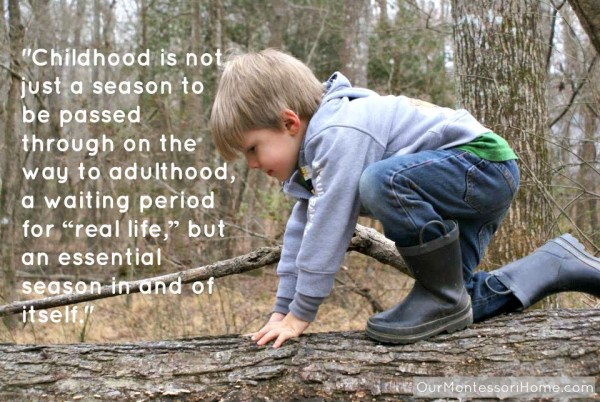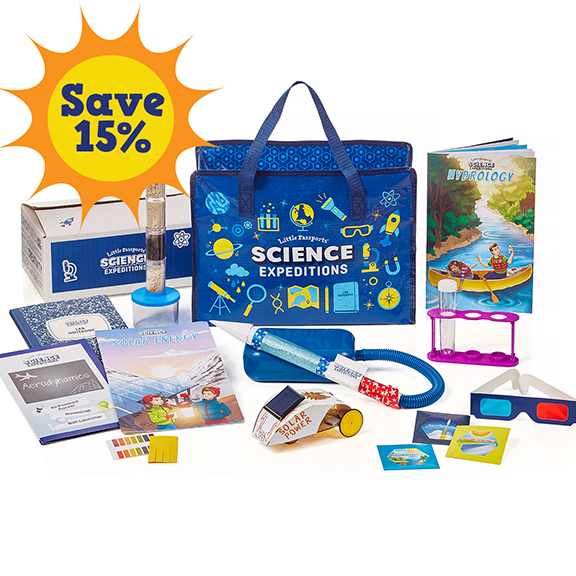Montessori is more than just beads and pouring, working on a mat, albums, and scope and sequences. It’s a whole philosophy based on seeing the child as a full, able, and independent person and cultivating an environment that allows the child freedom to explore and grow into their full potential.
Montessori saw the child not as an empty vessel waiting to be filled with a teacher’s knowledge, but as a being filled with life and wonder, possessing within the child all he or she needs to reach their full potential.
Children are not static, but active, eager explorers who pursue what interests as they take in the world around them.
We often view the child as an empty vessel needing everything to be poured in and programmed, when really all we need to do is stir the waters and gently guide their course.
Childhood is not just a season to be passed through on the way to adulthood, a sort of waiting period for “real life,” but an essential season in and of itself.
Montessori believed the child needed two things to thrive in life: access to his environment and freedom.
1. Access to the Environment
Through interaction with his environment, Montessori believes the child comes to understand himself, the limits of the world around him, and achieves “integration of his personality” (Lillard, Montessori: A Modern Approach, 30).
The child needs access to nature, real-life materials and activities, furniture and utensils fit to his or her size, and the freedom to touch, try, and explore. (For more on the child’s environment read The Prepared Environment.)
2. Freedom.
“Freedom is not only an external sign of liberty, but a means of education.”
Maria Montessori, The Montessori Method
The child must be free to move and explore, to take in the environment around him unhindered. Western thought has long held a separation between the intellectual and the physical, we’re slowing seeing this change. Montessori challenged this separation, “the full development of psychic powers is not possible without physical activity” (Lillard 31).
“Mental development must be connected with movement and be dependent on it. It is vital that education theory and practice should become informed by this idea” (The Absorbent Mind, Montessori 141-142).
Montessori continues that movement by itself isn’t the key, but purposeful movement “that the action which occurs is connected with the mental activity going on” (Montessori, 142).
For example, a child tracing the sandpaper letters is connecting the sound of a letter with the pattern the letter follows. Or a child gathering golden bead materials is able to see the visual difference and feel the weight of the numbers as he or she moves them from the shelf to mat and back again. They are interacting not only with the representation of the idea with their brain (the letter ‘a’ or the number 6,421), but are using their body to better understand each of these ideas. They are able to touch and interact with what is generally concrete.
On Becoming
The child possesses an intrinsic motivation to his own becoming, or self-construction. The full development of self is his goal in life. Don’t we often speak, as adults, of finding ourselves and becoming who we really are? The child has that same drive.
It sounds strange, doesn’t it? We don’t often think of the child as having a goal. We see them as haphazardly interacting in their environment—knocking books off the shelf, over turning a plant, breaking a toy apart to see what’s inside, using a toy for another purpose than its intended. To the untrained adult eye all these seem random, against the set “rules,” making more work for us, or even destructive. But if you take a closer look, the child is seeking to know and understand their environment. Their actions aren’t at all haphazard, they’re seeking purpose and understanding through experience.
The child doesn’t set out as an infant with the spoken intention of becoming their full self, but something deep within them calls to see and they do, move, explore, taste, touch, try until they have mastered their environment and through mastering their environment they are able to understand the different aspects of their world and how to live within it. They are finding their place and purpose. Montessori called this innate drive for knowing and exploration “the psychology of world conquest.”
Is this drive too self-centered and self-serving?
“Today’s principles and ideas are too much set on self-perfection and self-realization.” The goal of self-development is rather for service to mankind as well as individual happiness. (Lillard 31)
If we allow our children the freedom to explore and understand their environment, we are not only assisting them in becoming intelligent, productive, motivated, independent, free-thinking human beings, but people who see a world full of wonder and possibility and seek to do good.
Can the child achieve this purely on their own?
No, they need the guidance of a loving and patient guide who is willing to slow down, observe the child, amend the environment, and provide opportunities for this free movement.
The child has a predetermined pattern to guide his self-development, the “established models of behavior” to achieve it are not in place. Essentially, the child cannot get there on his or her own. These patterns are developed through sensitivities. “These inner sensitivities enable him to choose from his complex environment what is suitable and necessary for his growth. […] Sensitive Periods are blocks of time in a child’s life when he is absorbed with one characteristic of his environment to the exclusion of all others” (Lillard 32).
Sensitive periods occur in the child from birth to age 6 and are not seen in the same way the rest of life, then the child’s exposure and interaction with his environment in this season is of utmost importance. (We’ll look more closely at sensitive periods and the absorbent mind next week.)
What does all this mean for me?
Taking it home…
One of the greatest things we can do for our children is to look inward. What prejudices do we hold against childhood—particularly our own children in our home environment? How can we open our environment allowing our children greater access?
- Do you see yourself as the programmer of your child’s life—putting in all the data? Or do you see your child as a capable, independent human being?
- Are you too controlling? Do we allow for free play? Do we tell them how to play, work, color? Do we lead them in new activities? Do they see us pursue our own interests?
- Do we hover over their exploring? Don’t climb that tree! Don’t pick up dirt! Quit throwing the leaves…the rocks!
- Are children allowed to touch and explore, or are the limited to certain places in the home? Do we physically allow our children to explore the home and nature—are playpens, cribs, baby swings and the like used for the child’s development or for our convenience? If safety is an issue, how can we build an environment they are free to explore? If safety isn’t the issue, how can we limit the child’s time in these constrictive spaces?
- If these hindrances are for our convenience, how can we restructure our days and mental space?
- What can we let go of to provide our children with an environment that aids their growth and development?
These aren’t easy questions to answer or implement, but they’re not impossible. It can be uncomfortable to assess your life and realize you’re controlling (hand raised here), but wouldn’t it be better to realize that now and change? Not only would we be giving our children the freedom to become all they are, but we free ourselves to live a fuller life as well.
Don’t miss a post in the Montessori 101 Series by signing up for the Our Montessori Home Newsletter!
Linking up with Montessori Monday.


































3 comments… add one
I’m so glad you have some questions/take home points here. In reading through the explanation I thought I had a decent understanding and that maybe we’re already doing some of it, but maybe not ‘right’ or ‘well’. The questions though we’re a good place to kind of “check in” with myself and with our philosophy and goals as parents.
Now I feel even more informed and affirmed that our overarching goals and philosophies are in line (at least to a degree) in what Montessori really is and means, so far! 🙂
Yes! Love this post AND your post about how important it is that we talk about Montessori in layman’s terms. Sharing both in our Montessori 101 group on Facebook!
Nice article